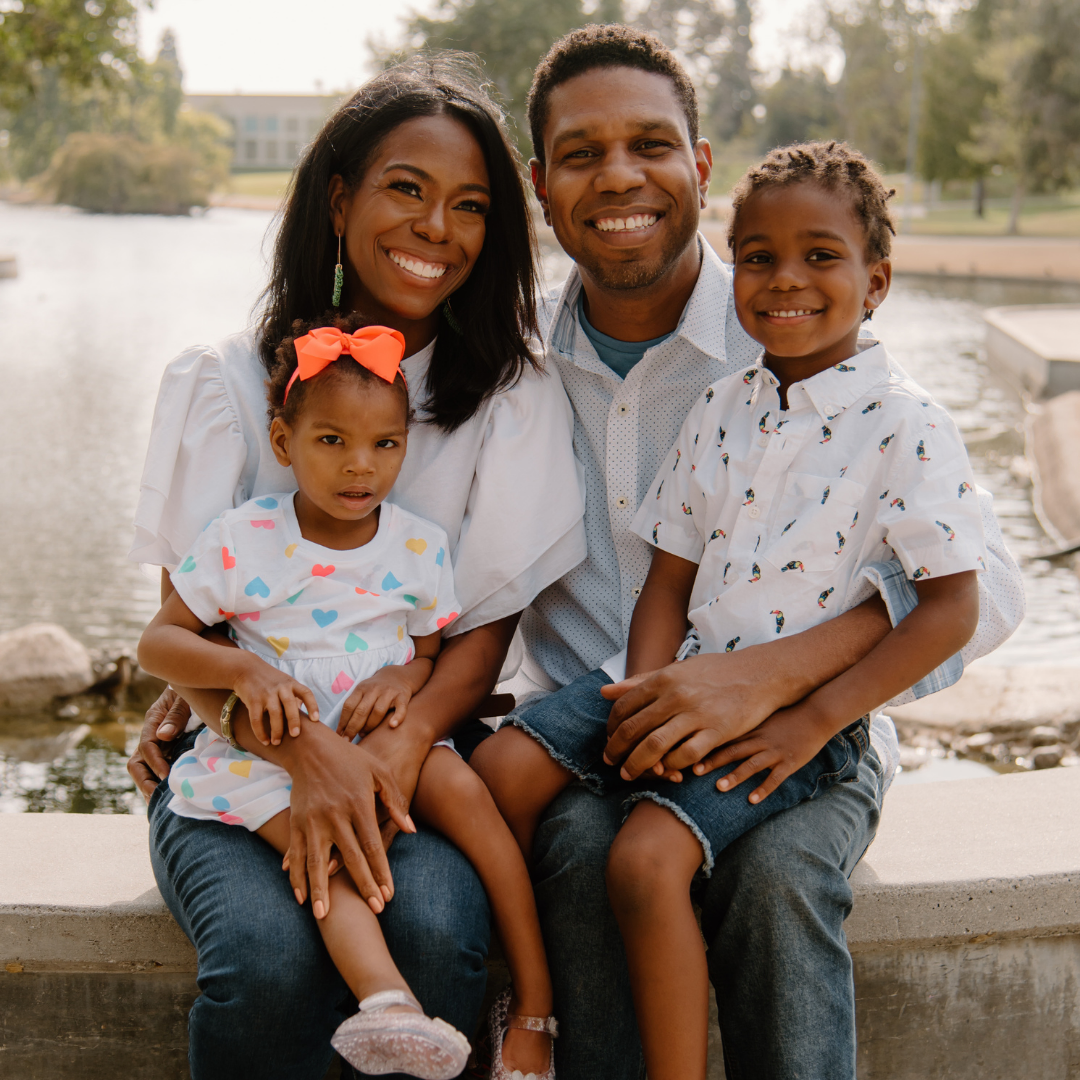One early January, an enchanting date night led to our enjoyment of smooth, jazzy tunes at the Hollywood Bowl. The cool, SoCal evening breeze danced its way around a sea of amphitheater seats, sending a delightful chill along the back of my neck as the trumpet and woodwind sections sounded in unison. I swayed happily, holding my husband’s arm in one hand, my precious bump in the other. I was feeling fine and free-spirited right up until I was surprisingly shaken… “Was that a kick!?!”
Although there were no medical signs of my baby ever being in danger – I’d been diligent with all of my prenatal appointments, eaten healthy, and exercised regularly – I always knew something wasn’t quite right. She rarely kicked or moved inside my belly. But I never admitted it to myself. Not until that night at the Bowl, at least.
Three months later, imminent signs of labor ascended upon me as I prepared a snack for my son. Following an indescribable, swift and intense two hours, our sweet girl, Nyla Ocean Guy, was born. She didn’t cry, though. She was awake and alert and beautiful, but not a single yelp. I held her in my arms, admiring her tiny, heart-shaped face. I wasn’t sure what was to happen, but I knew that I loved her immensely and that she was going to be okay. After 48 hours of hospital observations, a slew of tests, and doctor check-ins, we were allowed to go home since it would take some weeks to receive the final test results.
Shortly after arriving home from the hospital Nyla stopped drinking milk.
We were forced to syringe feed as I pumped around the clock in an attempt to keep my breast milk flowing. New-born infants are supposed to feed for about 20 minutes every 2-3 hours. It took us 2-3 hours to syringe-feed Nyla a mere 1-2 ounces of milk. After weeks of literally no sleep, more endless tests, doctor, and specialist visits, our lives were wrought with exhaustion, defeat and fear of the unknown.
The turning point was week six. We arrived at our follow-up specialist appointment and waited impatiently in the cold, fluorescent-lighted room of the genetics wing until two doctors walked in. The small talk that ensued was annoying to say the least. “Congratulations on your new baby, she’s beautiful; we understand you’ve been having some concerns and issues with Nyla the past few weeks,” they recited.
“Could you pleeeease just get to it,” I thought.
Finally, they shared the news with my husband and me. Nyla has a condition called Cat Cry Syndrome (aka Cri du Chat or 5p- syndrome). “That doesn’t sound terrible,” I laughed uncomfortably. “I can deal with a crying baby who sounds like a cat.”
Then, they handed us a five-pager full of scientific jargon-filled statements detailing just what having a child with Cri du Chat could mean. In layman’s terms it meant that a piece of her chromosome is missing and included the following: Gross and fine motor delays; Neurological challenges; Expressive speech and language delays; Poor muscle tone; Slow growth associated with failure to thrive; Constipation; Difficulty walking; Majority of children do not achieve toilet training; Sleep issues; Visual and hearing problems; Seizures; Few adults are able to live independently; ADHD; Poor concentration; Impulsiveness and OCD; Biting, hair pulling, pinching and hitting; Autistic-like characteristics.
We were completely overwhelmed.
I remember looking up at one of the doctors, wondering how I’d manage to make it through the rest of the visit without passing out. It felt like the ceiling was collapsing over me and someone had sucked all of the oxygen out of the room. I couldn’t pull myself together, nor could I stop my tears. I wished she was normal because normal was the only way I knew. I wished that she was back in my belly so that I could protect her and not deal with all of this disheartening news. The guilt, the idea that she…that we… would never have the life we’d planned was all too much.
“What did I do wrong?” I asked, barely able to string those five words together. Both doctors reassured me while my husband held our crying newborn and stroked my back. Turns out Cri du Chat syndrome is not always detected in the womb.
Once we made it home and the news of Nyla’s diagnosis set in, I was surprisingly relieved.
At least we now knew what we were facing. So, we sat down as husband and wife, talked through our grief and made a conscious decision to move forward in confidence that we were chosen for her and she was chosen for us. And we never looked back.
Early intervention began when Nyla was just two months old. Today we’re happy to say she’s thriving in her own way. Nyla is a busy three-year old! She undergoes around 10 hours of therapy per week to include physical therapy, occupational therapy, feeding therapy, speech therapy and infant stimulation therapy. She’ll even start a preschool program in the fall.
The daily therapies and services that she receives all have one very important thing in common: each help her to be the absolute best she can be.
Nyla is currently unable to chew her food effectively, walk, talk, play with one toy for more than two minutes, potty train, or follow basic instructions. She’s also extremely oral and she mouths anything she sets her sights on – the floor, your fingers, my fingers, clothes, paper; we definitely have to be watchful about what’s near her.
Raising a child with special needs is hard.
Every aspect of it. It is also one of the most unique experiences I could have never imagined. Listening to the sound of Nyla’s contagious, tickle-approved laugh when she sees my face each morning is worth it all. Or, when she watches her older brother drum on his djembe and is inspired to imitate him by drumming, too, is pure, unrefined joy.
I’ve discovered there is profound comfort in tossing expectations aside when it comes to Nyla’s development. In the past, I was missing the magic when I often worried about where she ‘should be’ at her age instead of focusing on where she was at that point in time. Now, I get it. These days I appreciate the notion that Nyla’s responses are usually delayed. For example, if I clap my hands, she may not imitate that clap until 20 seconds later. So, for at least 20 seconds, which can seem like a long time when anticipating a reaction, I get to: watch her splendid, sparkly, attentive eyes and observe how she processes that thing, learn and study her patterns, and gain a keen sense of forced slowness. It’s all quite remarkable, really.
We’d also be lost without the many avenues of support we’ve come upon throughout the past three years. Family and friends, Nyla’s amazing therapists, our phenomenal nanny provider (shout out to madammozelles.com!), and our wonderful extended family we’ve found with the nonprofit organization https://fivepminus.org/ have each been instrumental in helping us create an environment for Nyla to thrive.
Nyla can sign at least three ASL signs, including ‘more’, ‘eat’, and ‘all done’. She laughs a whole lot, she loves to travel, and she’s quite the little social butterfly (there are many more ways to communicate than through voice, you know). She’s also super chill and happy most of the time (she is a toddler after all).
Mainly, Nyla loves Love.
Every child is clearly different, but our descriptive words for those who support Nyla are that they must be loving, patient, attentive, and proactive. As long as she experiences those feelings, she will 1. Eventually achieve her goals to the best of her ability and 2. Capture anyone’s heart who happens to be within two feet of her.
Today, whenever a jazzy song pops up on Pandora, I embrace Nyla, hold her tight in my arms and rock with her in gratitude. She gets a real kick out of it; just as she did when she shook my belly that night over three years ago.
Nyla may never be considered a ‘typical’ child, but she is undeniably unique, lovely, sweet, smart, loving and exceptional in her own way. She’s taught those of us around her patience, resilience, determination, humor and more love than we could have ever imagined possible. She is proof that we must trust the paths we’re on. There are no mistakes. Nyla is the Light that’s made our family complete.
May 1 – 10 is Cri du Chat Awareness Week. To celebrate, we wear stripy socks, one short and one long to indicate the chromosome deletion, and we participate in an international virtual 5k for 5p- walk. This will be our third walk and it’s definitely becoming an anticipated highlight of our year.
The US Nanny Association thanks all the nannies, advocates and business leaders who provide practical tips and insight to elevate our industry. Thank you for sharing your expertise.

Article Author: Janie Guy. If you are interested in learning more about Nyla’s syndrome or how to support special needs individuals, check out fivepminus.org/resources for information on support groups, charitable and government services, and publications.
